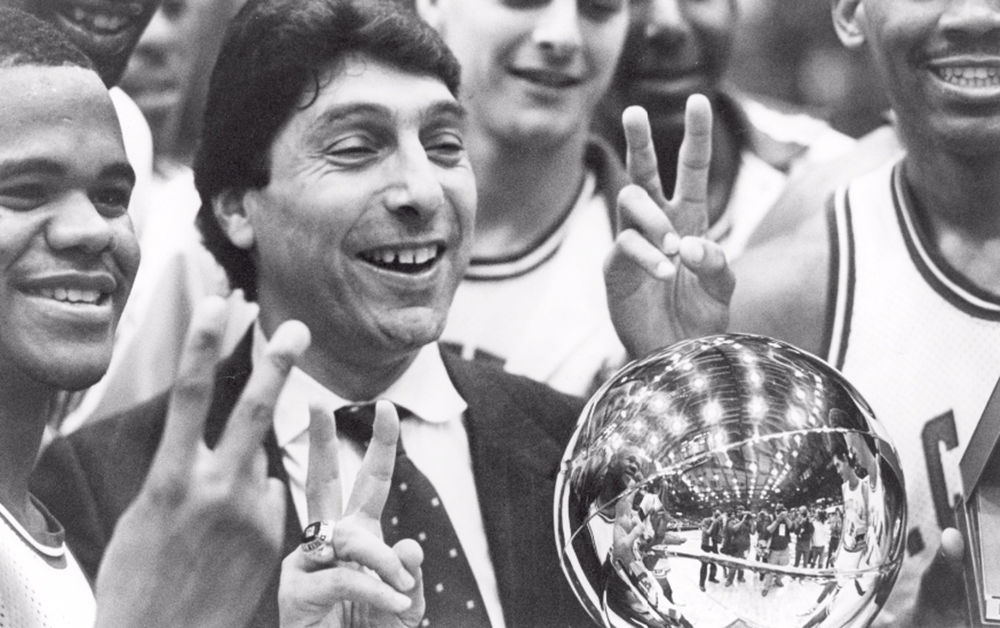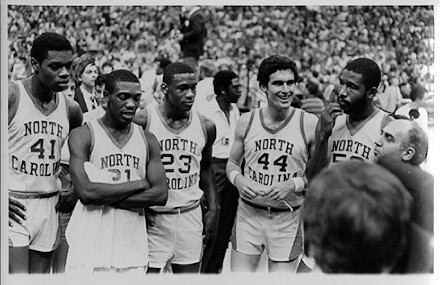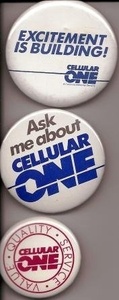How I got Coach K to leave the locker room at half time of a Duke v UNC basketball game
In the late winter 1986 I was fortunate to be standing in the right spot when two events crossed and offered an opportunity to leverage the power of story for my company’s business advantage.
Our team of corporate backed entrepreneurs was approaching a half year since we launched Cellular One of the Triangle, the first cellular telephone company in Raleigh-Durham-Chapel Hill. (A quick historical note for those too young to know: cellular service was rolled out by the FCC as a local market business, with two licenses for each MSA. Our team, as Providence Journal Cellular, went on to build over 20 local cellular companies.)
And over at Duke University in Durham Coach Mike Krzyzewski was in the middle of an extraordinary regular season that would eventually be his first run to the Final Four and the beginning of the Coach K phenomena in college basketball.
As we were developing early marketing strategy in those pioneer days of cellular telephony—when phones were car mounted and cost $5K—we decided that we would focus on the real estate professions, folks who lived in their cars. It didn’t take long to realize that just about every real estate broker and agent and developer and appraiser and contractor was a fan of one of the three local college teams, the UNC Tarheels, the NC State Wolfpack, or the Duke Blue Devils, so I decided to invest our budget aggressively in the schools’ marketing opportunities like game programs and signage and radio broadcast sponsorships.
I started at NC State, just two years off their National Championship, coached by Jim Valvano. We wanted Valvano to do a TV spot for us and he agreed. Or rather his business manager did, who also insisted that “Jimmy won’t work with a script. Give him the concept and the time restrictions and he’ll ad lib it.”
The concept was he was tailgating at a NC State football game and, wanting to order something from his favorite Italian restaurant, he’d use someone’s Cellular One car phone to call in his order. And he had 25 seconds of our 30 second spot to work with.
What a pro. His first take was 24.5 seconds. His second was 24.1 seconds. Each take was uniquely hilarious.
UNC was next, and they were just three years off their National Championship.
I approached them in the same manner I approached NC State but I was not greeted with any sort of enthusiasm; they saw us as a start up that could easily fail and stick them with a bunch of unpaid invoices. So I invested at their school the best we could, then moved on to Duke.
Duke was deeply appreciative when they saw we were treating them with the same regard we showed the other two schools. For quite a while they had been a very distant third in the Big 3 pantheon—those years State and UNC were winning national championships, for instance, Duke with Krzyzewski as coach had won 21 games and lost 34. Yes, he’d made great progress in the next couple of years but Duke wasn’t much more than an afterthought among the great majority of residents of the Triangle at the time.
But here in 85-86 season it was all coming together for them, achieving the #1 ranking in the country for the first time under Krzyzewski, and in the middle of the season I got a call from Johnny Moore, the Assistant Sports Information Director for the Duke Athletic Department. He was relaying an offer from Coach K. He’d been approached by some companies interested in knowing if he’d do commercials. He had been impressed, Johnny said, that “Cellular One had jumped on the Duke bandwagon before there was a bandwagon” and so to try out being in a commercial in his own backyard and as a display of gratitude for our support, he wanted to do a TV spot for us for free.
Our good fortune just got better when I realized that the final game of the regular season was a home game for Duke against UNC—they are always scheduled to play each other to end the season—and it was also the day after our first major marketing campaign of our short history, ‘The Excitement is Building in the Triangle Sweepstakes’, was ending. So I bought a 30 second slot at half time, then called Johnny Moore with my idea.
I told Johnny about our sweepstakes ending the day before the game and that I had purchased the half time TV slot. I painted the picture for him: We’d set up the drum with all the sweepstakes entries just outside the door of the locker room and have our General Manager turning the handle, waiting there for Coach K. At the appointed time all Coach K would have to do is excuse himself for a moment, step outside the door, pick an entry and congratulate the winner, and he could head back in, taking maybe 30 seconds of his time total.
Johnny said “No way he’s going to leave the locker room at half time.”
I said I figured that was so, so instead what I wanted him to do was come to work the Wednesday before the game in the exact clothes he would wear for the game on Sunday. We’d set up as described, he’d come out of the locker room to choose the winner, the GM would say “Thanks Coach and good luck in the second half” and we’d dub in background crowd noises and ‘The Devil with the Blue Dress’ music often played by the Duke pep band, and run the taped 30 second spot at half time. Johnny thought Coach K would get a kick out of that and he did and we shot the spot.
It was Friday before the game, someone suggested we gather together to watch it, and a bunch of us did. Duke was #1 in the country going into the game, UNC was #3. At the end of the half Duke was ahead 37 to 34 and I said to the gathered group “Oh no. What if Duke winds up loosing this game and the commercial does look like it was live and folks blame us for distracting Coach K at half time.” Someone quickly responded “If that’s what happens keep in mind there are a couple hundred Tarheel fans for every Duke fan watching, so they’ll love us.”
Well the spot ran–Duke won the game 82 to 74–and it looked so much like it was live that the next day we got well over 200 phone calls from folks asking how we got Coach K to leave the locker room at half time of the game. We of course told them the truth, and virtually everyone thought the truth was even cooler.
In those early days all new customers were asked to complete a short profile about themselves. Over a year after we ran this spot the #1 answer to the question ‘How did you first learn of Cellular One?’ was a reference to us being the company that got Coach K to leave the locker room at half time of the Carolina game.
If you want dramatic results in your business you should use story for dramatic amplification of your message. We’ve been telling each other stories for roughly 40,000 years and because of the biological concept of neuroplasticity–our brains change to be more effective at how we use them–our brains have become story telling machines. We want to understand the world around us through stories.
I like to talk about story as the one and only Universal Knowledge Management Technology–story imbues information with meaning, stores it, shares it, and makes it actionable. I have helped a number of companies craft their best stories–the ones that have the most significance to their key constituencies–and continually marvel at the power that comes when you get your story working for you.






